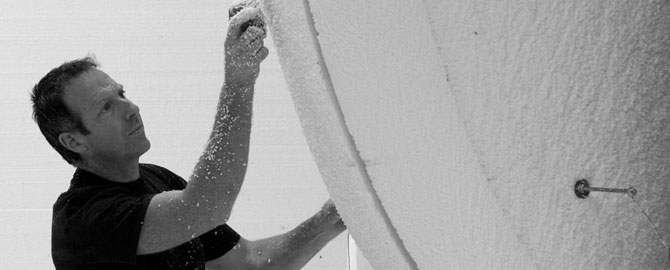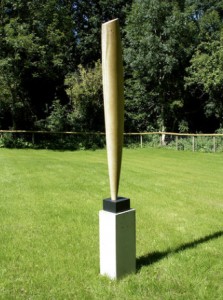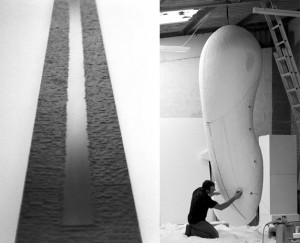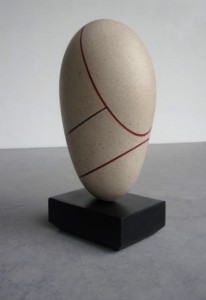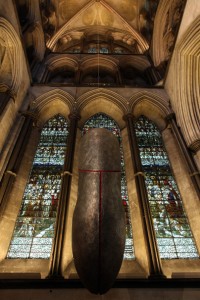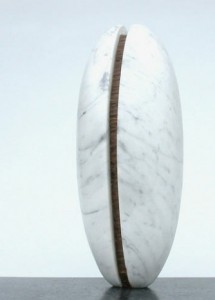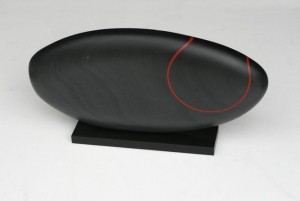Jay Battle started his sculpture career as an apprentice in architectural stone carving. It was here that he developed, in addition to his technical knowledge and sculptural finesse, a love for materials- in particular stone.
Battle’s approach to Sculpture is refreshingly ‘old-school’. His work fuses a variety of materials, however the form of the sculptures remain gently composed and tranquil. Each piece celebrates the beauty and characteristics of his chosen natural and local materials; when juxtaposed their relationship becomes an aesthetic marriage. Each material is sculpted and fashioned, going through a series of processes that highlight each other in the most beautiful of states.
In the late 80‘s Battle moved to the UK, where he became Head Carver for Salisbury Cathedral. It was during his time there that he started to explore his own ideas and self-expression. Battle’s work includes a series of sculptures for the West Front of Salisbury Cathedral and public pieces in and around the cathedrals’ The Close.
In His own words
Why are you an artist? Did you ever feel that you had a choice?
The need or want to externalise has always been there. Initially through music and then when I discovered sculpture, it was the right answer at the right time.
Before engaging with contemporary art I had been working with medieval sculpture architecture, and I was always inspired by the way that the craftsmen at that time were expressing the experiences, judgement and feelings of the period. The respect I felt for their work affirmed a path for me to find my own language for my own time. I’m not sure there was a choice. When I am not able to work, I do become pent up and……….. quite annoying to be with. There are certainly times I’ve wished I could be content with a career that is more conventional and straight forward but this delusion never lasts for long.
You’re well known for creating ‘Slated Divide’ in Salisbury, which was how I actually first came across your work. In your opinion, how does being situated in such a famous setting effect the form and scale of your work?
I do have a history with the Cathedral in Salisbury which has helped me to find my way to contemporary sculpture. I do love living here and it certainly provides us with a great amount of peace and humility. Strolling through the city and the tremendous amount of history it offers is a great way of helping to clear my head and provide a perspective when things are not going well out at the studio.
The scale of any piece finds itself really unless it is site specific. The patterns and characteristics of material can influence or even dictate the scale. I find that there is never any point for me in being too clever with materials. I need to be true to the inherent strengths or weaknesses to feel I am being honest. For the forms, I normally have a few basic pursuits which involve continuity of line, considered proportions of mass and its division.
Where do you take inspiration from?
On the whole, I am inspired by the relationship between our built and natural environments. How one forces itself on to another. I try to express this relationship by rearranging natural materials or showing my imposition on them.
In your opinion what are the fundamental disciplines or media do you find integral to the work of an artist and why?
I am never sure about this. I think it depends on the language as some need to reinterpret, some need to work in a reductive manner starting with a finite boundary and some need to build up or assemble. I think any success lies in what you produce and not how you get there. I have seen plenty of unsuccessful work which has clearly been produced skillfully, with a committed amount of study and time but in the end, it is still unconvincing work. It is about judgement, honesty and individuality rather than any quantifiable skill. Saying that, although I am happy to give credit to the aesthetics or message of a fluke, an artist will certainly not be able to build a body of consistent work based on luck for very long.
I have seen some remarkable work by children who have the most pure and honest connection to themselves. The charm and strength of this work, although not sophisticated, connects with the same clear, visceral judgement that has directed so many successful works.
That is not in any way to undermine skill. You are liberated by skill as the more you possess the less you have to think about mechanics of your technique. With that there can be a stronger potential of any connection to this ‘self’. The problem can lie in becoming too clouded by technique, letting it get in the way of your true communication.
What role does the artist have in society?
Any person communicating an idea or experience has the potential to speak to the rest of us, by bringing a different perspective into our lives which can have lasting effects. I’m not sure exactly how society benefits from this collectively as these experiences are so very private and intimate. I guess at its most dramatic, they reconnect us to ourselves. We are certainly in an age of bombarded external, transient stimulus which is distracting enough to drown out any inner connection.
What art do you most identify with?
This tends to relate to feeling rather than any society benefits from this collectively as these experiences are so very private and intimate. I guess at its most dramatic, they reconnect us to ourselves. We are certainly in an age of bombarded external, transient stimulus which is distracting enough to drown out any inner connection.
What work do you most enjoying doing, and why?
Once I believe I know the rough direction a work is taking I tend to work very quickly. The early part of roughing out these ideas is very satisfying. In many instances these stages provide a very positive atmosphere and offer glimpses into further avenues of work or experiment. You’re at a point where you can go in so many directions. Commitment can prove tricky in these stages as the sense of freedom is immense. In the end of course you need to produce something and know when it’s done but while you are floating through ideas and your body and brain are racing on the potential of something working out, you experience a remarkably privileged state.
Jay Battle was born (May,1966) in Toronto, Canada, he now lives and works in Salisbury, in the UK. In 2003 he was invited by the Royal Society of British Sculptors to become an Associate Member. Battle frequently exhibits in the South of England.
All images courtesy of Jay Battle | www.jaybattle.com
For more information on Hong Kong Art Tutoring please contact:
Gail Deayton
Telephone: +852 9722 8353
Email: gd@gaildeayton.com

